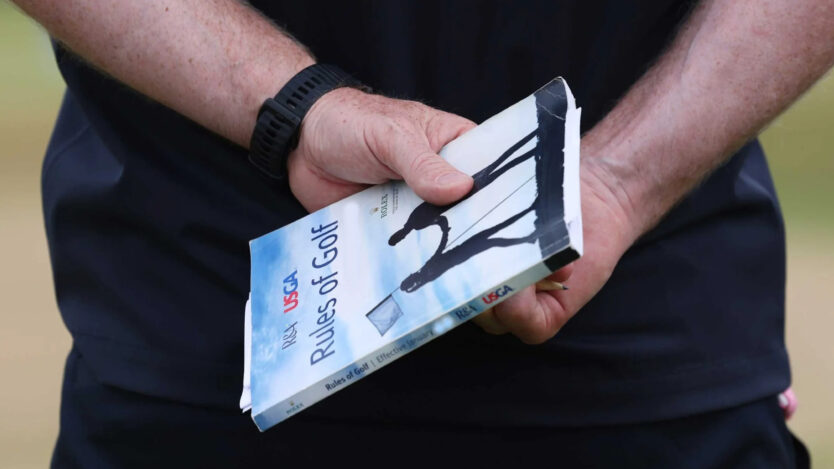If you can stop your golfers making these mistakes in competitions, your lives will be a whole lot easier…
This article is part of GCMA Insights – topical content for golf industry professionals, discussing the things that matter to those who work in golf clubs.
Some golfers believe the Rules of Golf to be really complicated. Too complicated. It’s true that any sport played over a 100-acre patch of land has its quirks.
There are dozens of subsections and clarifications that add to the main 25 playing rules that form the big book.
But they’re largely not the ones that are catching members out in competitions. No, the ones that cause the real grief – and are the most unwittingly broken rules – are very straight-forward.
So let’s get into the five Rules your members are always getting wrong. Set then on the right path with this quintet and you’ll find administrating your events a much calmer experience…
Lifting a ball to identify it without marking first
Easily the number one rule I see broken on a golf course – and by players who have been competing at a high enough level to know better.
Players are allowed to identify their ball to check it is theirs. They don’t have to tell their playing partners they are doing this.
What they do have to do, however, is mark the ball first before they lift or rotate it. If they just bowl in there and pick it up without marking it first, they’re going to pick up a one-shot penalty.
Players can’t clean their ball any more than necessary to be able to identify it. And they must replace the ball on its original spot.
Get involved in the debate.
To join the GCMA, click here, or to organise a call with a call with a member of the GCMA team, just complete the form below.
It’s three minutes to find a golf ball
That’s three minutes. Not five – that hasn’t been the case since the start of 2019 – and it’s certainly not whatever time that suits your players until they find the ball.
But this is just part of the dispute. How do you sort it out if one player accuses another of taking too long to search for a ball?
They may be convinced the sands of time had run out, but if they’re unable to prove it how can you make a judgement?
You can’t. What you can do, though, is advise competitors to start a stopwatch, or a timer on their phones, when a search begins. Then, everyone is clear on when time has run out and you’ve got evidence to lean on is someone makes a complaint.
Known or virtually certain in penalty areas
To take penalty area relief, players have to know – or be virtually certain – their ball is in that penalty area.
That means they’ve seen the ball enter it, saw a splash, or their playing partners, or other golfers on the course, saw that ball enter the penalty area.
Virtually certain means that it’s at least 95 per cent likely the event in question happened. If their ball could be lost in long grass, or trees, or anything outside of the penalty area then it isn’t virtually certain.
It’s important your players grasp that point because it means they can’t simply wander up and take lateral relief if it’s a red penalty area.
If they haven’t already played a provisional – which they can do because their ball MIGHT only be lost in a penalty area – then stroke and distance relief (going back to where they originally played) is their only option.
WHY JOIN THE GCMA?
Membership of the GCMA unlocks a network of like-minded professionals, provides you with support in your professional and personal development, and provides you with a multitude of benefits. Whether that’s the tools that will help you to excel in your profession, or a wide range of services to support your wellbeing, signing up to the GCMA is joining a community.
Dropping it wherever they like
Hey, we’re back on penalty areas again. That’s because they cause members lots of problems. If they’ve hit the ball into a pond, for example, and they decide they’re going to take back-on-the-line relief, they can’t just drop it wherever they like in front of that pond.
How many times have you seen a golfer smack in a stream and then just wander down and drop a ball right in front?
But they must use the last estimated point where the ball crossed the penalty area and then go back keeping that spot in line with the flagstick.
Depending on the pin position, that can be a long way away from just chucking one down and leaving a flop over the water.
Players can’t decide rules are between themselves
You’ll all have heard this one. A group got themselves in a quandary on the course and, rather than check out the rules (you can do this one your phone with the R&A Rules App), or give the club a quick ring, they clubbed together and decided what the rules probably say.
The problem with that approach in a stroke play competition is that those rules specifically forbid them doing that.
While players are encouraged to help each other when applying rules, they’ve got no right to decide a rules issue by agreement.
Worse than that for them, it’s not binding. Players don’t have to agree to it, and neither do your competition committee.
They should always raise any issues with that committee before returning their scorecard. And if they are genuinely stuck in stroke play, play a second ball.
This article is part of GCMA Insights – topical content for golf industry professionals, discussing the things that matter to those who work in golf clubs.
Get involved in the debate. To join the GCMA, click here, or to organise a call with a member of the GCMA team, just complete this form and we’ll be in touch!
Enquiries
"*" indicates required fields



